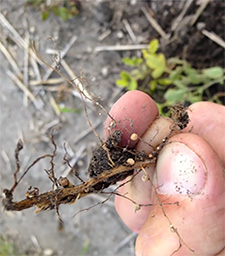Resistant Modes of Action
Resistance genes from PI 88788 are the cornerstone of genetic resistance to SCN, and widely available to the industry. PI 88788 was first identified to have resistance to SCN in 1962. Mitchum explains that this multi-gene trait has a single locus, which for breeders means this is a single-gene trait, with only one marker needed, and was relatively simple to move into production. The first soybean variety containing PI 88788 resistance launched in 1978 eventually taking over the market. There was another resistant source discovered in 1957 called Peking (PI 548402), which saved producers millions of dollars in the 1970s and 1980s, especially in the Southeast, but relies on a three-gene model.

Tylka notes that most variety development programs lean on PI 88788, but seed companies are exploring Peking. Before the advent of molecular breeding, which allows breeders to select the resistance genes and enrich them in their best germplasm, it was a step backward to breed with Peking varieties. But with today’s breeding strategies, genetic information and molecular markers, progress is ramping up to bring new genes for resistance to combat SCN to the customer.
For breeders, the challenge now is that genetic resistance is an either-or choice. Stacking PI 88788 with Peking isn't possible, so it is a germplasm switch. Mitchum adds that there is work underway to identify viable gene stacks that do have some added benefit. For example, PI 88788 combined with genes from Glycine soja, a wild soybean. As for Peking, farmers are going to find more soybeans on the market carrying that trait.
There are also other SCN resistance traits being developed by University (public) breeders using other sources, and there's another – PI 89772 – that's being commercialized and may hold promise.
"We have quite a bit of work going on right now," says Mitchum. "Checkoff dollars are going towards research to try to figure this issue out, and we have a number of programs looking at various rotations and how these might be effective. With the North Central Soybean Research Program we have a multi-state effort among breeders, geneticists, nematologists, and bioinformaticists working together to try to figure out what combination of genes will work best and how we can deploy them in a rotation."
And that's the new added challenge. Simply planting the resistant variety and moving on won't work anymore.


